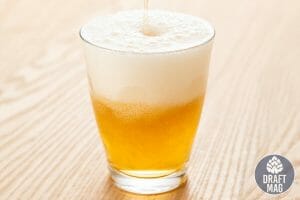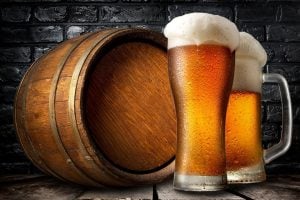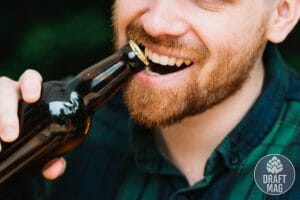How To Whirlpool Hops? The Easiest Way to Enhance Beer’s Flavor!
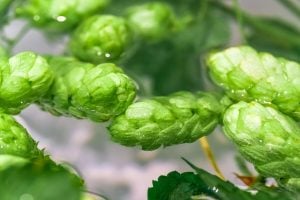 How to whirlpool hops? Read on and find it out in this article! The first thing you want to know is that whirlpool hops get this name because a whirlpool results due to the recycling of wort. The hop aroma oils add a much more pronounced flavor and aroma to the beer.
How to whirlpool hops? Read on and find it out in this article! The first thing you want to know is that whirlpool hops get this name because a whirlpool results due to the recycling of wort. The hop aroma oils add a much more pronounced flavor and aroma to the beer.
After reviewing the whirlpool hopping strategies of the professionals and homebrewers, we have brought you a comprehensive whirlpooling hops guide.
How to Whirlpool Hops? With and Without Pump
Whirlpool hops is an inexpensive technique compared to hop bursting due to many reasons. One of these is that it’s possible to create a whirlpool with or without a pump. There is no need to spend money on expensive whirlpool brewing equipment.
So, if you’re a homebrewer and want to preserve your beer flavor, then you must try this technique. The two ways to whirlpool hops are:
– Whirlpool hopping with pumps
 Commercial breweries use whirlpool brewing equipment with pumps. The process of adding whirlpool hops using pumps consists of the following steps:
Commercial breweries use whirlpool brewing equipment with pumps. The process of adding whirlpool hops using pumps consists of the following steps:
- Give the wort a boil in the kettle and allow the temperature to drop. When the mixture cools down, start adding hops once a whirlpool forms.
Note: If you don’t have the facilities to cool down the kettle mixture, turn off the flame after boiling. Allow the temperature of the wort to fall before moving on to the next steps.
- The pump transfers the wort to the whirlpool vessel at a rapid velocity. The usual speed is 15 feet per second, which causes the wort to spin and create a whirlpool.
- In commercial breweries, this process requires an appropriate temperature and a specific time. After that, the mixture of the whirlpool vessel is allowed to stand for about 20 minutes. The hops and trub mix well during this standing step to form a hop pile or compact trub at the vessel’s center.
- At a specific temperature during the whirlpooling, the volatile hop oils become soluble in the wort. The wort is then separated from the hop pile through an outlet on the side of the vessel.
– Whirlpool hopping without pumps
If you’re a homebrewer, then whirlpool hopping without pumps is for you. The process is almost the same, except a pump isn’t present to create the whirlpool. The steps in whirlpool hopping without pumps include:
- Boil the wort in the vessel to attain the temperature required for whirlpool hop addition.
- To create the whirlpool, use a mash paddle or appropriate spoon. Stir the wort and hop mixture in a circular motion to create a mini-whirlpool. At this point, add the whirlpool hops to the vessel. Continue the stirring for at least 1 to 2 minutes before allowing the wort to stand.
- Then, leave the wort for about 10 to 20 minutes. Before transferring the wort to the wort cooler for chilling, give it a quick stir. This extra step helps to improve the results.
When To Add Whirlpool Hops in Wort?
Once the whirlpool starts in the vessel, you can add whirlpool hops into it. The hop oils transfer their aroma and flavor to the wort, but not bitterness. The hop oils in the hops are mostly volatile, which means they can quickly evaporate if the temperature increases.
Moreover, at higher temperatures, the isomerization of the alpha acids of hop oils also increases, leading to bitterness. Therefore, if you want a huge portion of hop oils and little bitterness, the ideal temperature is 180 °F.
Should You Cover the Pot During Whirlpool Hopping?
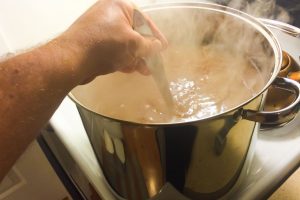 No, you shouldn’t cover the pot during whirlpool hopping, and here is why: When you cover the pot, the off-flavors volatile substances such as dimethyl sulfide (DMS) remain in the wort. The presence of DMS can destroy the taste of the beer.
No, you shouldn’t cover the pot during whirlpool hopping, and here is why: When you cover the pot, the off-flavors volatile substances such as dimethyl sulfide (DMS) remain in the wort. The presence of DMS can destroy the taste of the beer.
But there is a counter perspective, too, that says you should cover the pot during whirlpool hopping. It stops the vaporization of quickly vaporizing hop oils such as myrcene. By covering the pot, you can preserve some of the myrcene and other quickly evaporating hop oils.
So, the final decision is up to you. You can either keep the pot covered or not — although the first option risks jeopardizing the results if you are not an expert.
How Long Should a Whirlpool Last?
While most websites say that a whirlpool should last for 10 to 20 minutes, this is not true. The process isn’t that simple and is more concerned with a specific temperature than time. The ideal temperature creates the least amount of bitterness and most flavor or aroma in the beer. In short: Take your time!
Whirlpool Hops Temperature: Hop Oils Preservation
Temperature is a significant factor in preserving the aroma oils in the beer. As many hop oils are volatile, they require a temperature below the boiling point. If the temperature increases, they evaporate and will not be present in the beer.
To preserve these oils in the beer, whirlpool hop additions play a critical role at a temperature below boiling. There are different temperatures at which whirlpool hops additions are made to the wort. These include:
– High whirlpool range
It’s also known as the high isomerization range, and the temperature for this is about 185-210 °F (85–99 °C). In this temperature range, some of the hop alpha acids are still isomerized, due to which a trace of bitterness is added to the beer.
You can use this temperature for whirlpool hops if you want a bitter flavor with some hop oils in your beer. But keep in mind that, at a higher temperature, there is more risk of vaporizing large amounts of hop oils.
– Medium whirlpool range
The temperature for the medium whirlpool range or medium isomerization range is 160–170 °F (71–76 °C). As the name indicates, there is a little isomerization that will not add much bitterness. Moreover, the volatilization of the hop oils is reduced, so you’ll get a larger portion of hop oils.
The best thing about medium-range whirlpooling hops is that the wort remains hot enough to enhance hop oils’ solubility. Moreover, this range doesn’t require an excessively long whirlpool. It’s best for you if you’re a homebrewer and want to keep the whirlpool time short while preserving hop oils.
– Low whirlpool range
In the low whirlpool range, the temperature is 150–160 °F (60–66 °C). At this whirlpool hops temperature, the volatilization of the hop oils will be less due to a lower temperature. But this decrease in temperature will also reduce the solubility of hop oils; thus, a longer whirlpool is required.
This temperature range is mainly used to preserve highly volatile and less soluble hop oils, such as myrcene. Also, some pro brewers use this as they have better control over the whirlpool temperature and time.
Does Hops Quality Affect Beer Quality?
Yes, the quality of hops affects the beer quality during whirlpool hopping. High-quality hops that tend to be expensive have a high level of aroma and better flavor. Moreover, the bittering content of quality hops is less than the typical hops.
Can a Wort Whirlpool Save You Money?
Yes, it’s possible to save money using a wort whirlpool in the long run. When a whirlpool is created, the energy flow in the liquid increases. This increased energy leads to faster heat dispersion, which causes the temperature to fall quickly.
The few ways this process can save you money are:
- There is no need to spend money on expensive products to speed up cooling.
- The time to run plate chillers or other products that require electricity reduces significantly. This, in turn, saves money by reducing energy costs.
- If you opt for an ice bath for cooling wort, the amount of ice required to cool the surrounding water is much less.
Whirlpool Hops Utilization
Whirlpool hop utilization helps in calculating the amount of hops utilized during the whirlpool. It helps maintain the IBU (International Beer Units) balance of beer when a large number of whirlpool hops are added.
The calculation of whirlpool hop utilization shows that the utilization decreases as the temperature falls. At a lower temperature, some of the isomerizations can still occur. But remember that isomerization is just a side product of whirlpooling. The primary goal is still to preserve the hop oils in the beer.
To calculate the whirlpool hop utilization, you must have an idea of the isomerized hop alpha acids. Moreover, you should also know the alpha acid percentage that was not isomerized in the whirlpool. To have an accurate value, the utilization is calculated for each hop addition.
FAQ
How do you whirlpool hops without a pump?
To whirlpool hops without a pump, stir the wort with a spoon for 10-15 minutes, then let it settle for another 10-15 minutes before siphoning or racking.
What temperature should you whirlpool hops at?
Optimal whirlpool hop temperature varies but generally ranges between 170-180°F (77-82°C) for 20-30 minutes.
How long should you leave hops in whirlpool?
Leave hops in the whirlpool for 20-30 minutes before cooling the wort for best results. Longer times may increase bitterness and hop utilization.
Conclusion
We have covered all that you should know about whirlpool hops in this post. Let’s have a quick glance to ensure you haven’t missed any crucial points.
 There are two ways for whirlpool hops: one is best for commercial breweries, the other for homebrewers.
There are two ways for whirlpool hops: one is best for commercial breweries, the other for homebrewers.- The goal of the process is not to add much bitterness and to preserve hop oils that add aroma and flavor to the beer.
- Medium temperature range is the best range to get a large portion of hop oils with little whirlpool time.
- A successful whirlpooling depends on a specific temperature, not time duration.
- High-quality hops produce better beers due to less bittering content and a high amount of aroma oils.
- Whirlpool hop utilization reduces with a decrease in temperature.
Whirlpool hopping is an easy and quick way to make quality beers, as it reduces bitterness while adding flavor. Even if you’re a homebrewer without any extravagant brewing devices, you can give it a try. With a bit of effort, the results you’ll get will be amazing!

 There are two ways for whirlpool hops: one is best for commercial breweries, the other for homebrewers.
There are two ways for whirlpool hops: one is best for commercial breweries, the other for homebrewers.